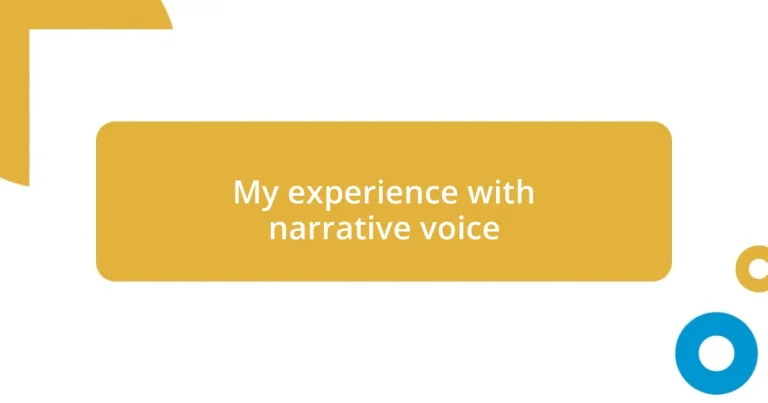Key takeaways:
- Narrative voice is crucial in shaping reader connection and emotional engagement with characters.
- Different types of narrative voices (first-person, second-person, third-person limited, and omniscient) each create unique experiences for readers.
- Personal exploration through techniques like journaling in character voice and understanding dialogue can enhance narrative authenticity.
- Analyzing successful examples, such as “The Catcher in the Rye,” reveals how well-crafted voices resonate deeply with readers, transforming characters into relatable figures.
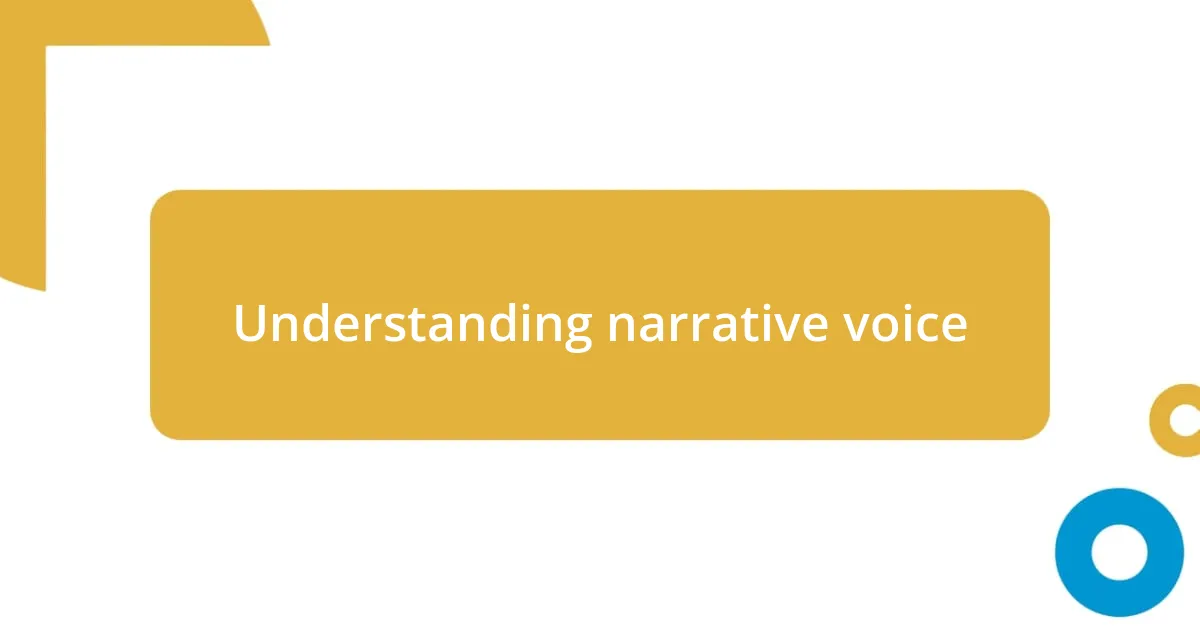
Understanding narrative voice
Understanding narrative voice goes beyond just the choice of words; it embodies the unique personality that shapes a story. I remember feeling drawn into a novel when the narrator’s voice felt as familiar as an old friend, making the characters and their struggles come alive. Isn’t it fascinating how a distinct voice can evoke emotions so deeply, transforming a simple plot into something memorable?
When I first explored different narrative voices in my writing, I realized how significantly they influence the reader’s connection to the story. For instance, I experimented with a first-person perspective in a short story, allowing my protagonist’s fears and dreams to shine through. It was an eye-opening experience — don’t you think a character’s internal dialogue can resonate with our own thoughts, creating a profound bond?
Engaging with narrative voice can feel like a dance between the author and reader. I find myself often pondering: how does a shift from a third-person to a first-person voice change the dynamics of a story? Each decision about whose voice is telling the story can lead to entirely different emotional landscapes. Understanding narrative voice, then, becomes a journey of discovery that enhances both our writing and our appreciation of literature.
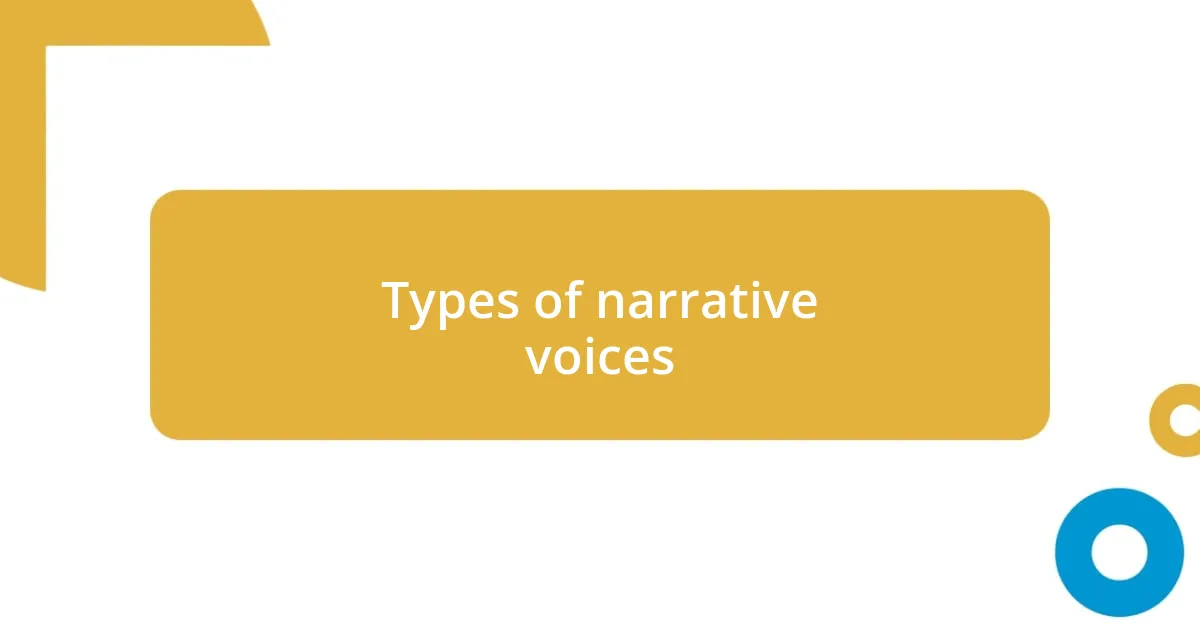
Types of narrative voices
Narrative voice plays a crucial role in shaping a story and its emotional pull. Over the years, I’ve encountered various types of narrative voices, each bringing its own flavor to the text. For instance, switching between first-person and third-person perspectives can create entirely different experiences for the reader. Sometimes, I find myself reflecting on how a third-person omniscient voice offers a wide lens on character motivations, while a first-person voice pulls me into the intimate thoughts of a single character. The contrast is striking and can evoke completely different feelings.
Here’s a quick breakdown of the main types of narrative voices:
-
First-person: The narrator is a character in the story, using “I” or “we” pronouns. This voice gives personal insight but can be limited to the narrator’s perspective.
-
Second-person: The narrator addresses the reader as “you,” creating an immersive experience. It’s less common, but it can draw readers in vividly.
-
Third-person limited: The narrator knows the thoughts and feelings of one character, allowing for deeper emotional connection without the constraints of first-person.
-
Third-person omniscient: The narrator knows the thoughts and experiences of all characters, offering a broader perspective. This can create a richer world but may distance the reader from individual characters.
Exploring these types in my own writing has been enlightening. Each voice shapes the landscape of the story in unique ways, making decisions about narrative voice essential for crafting a compelling tale.
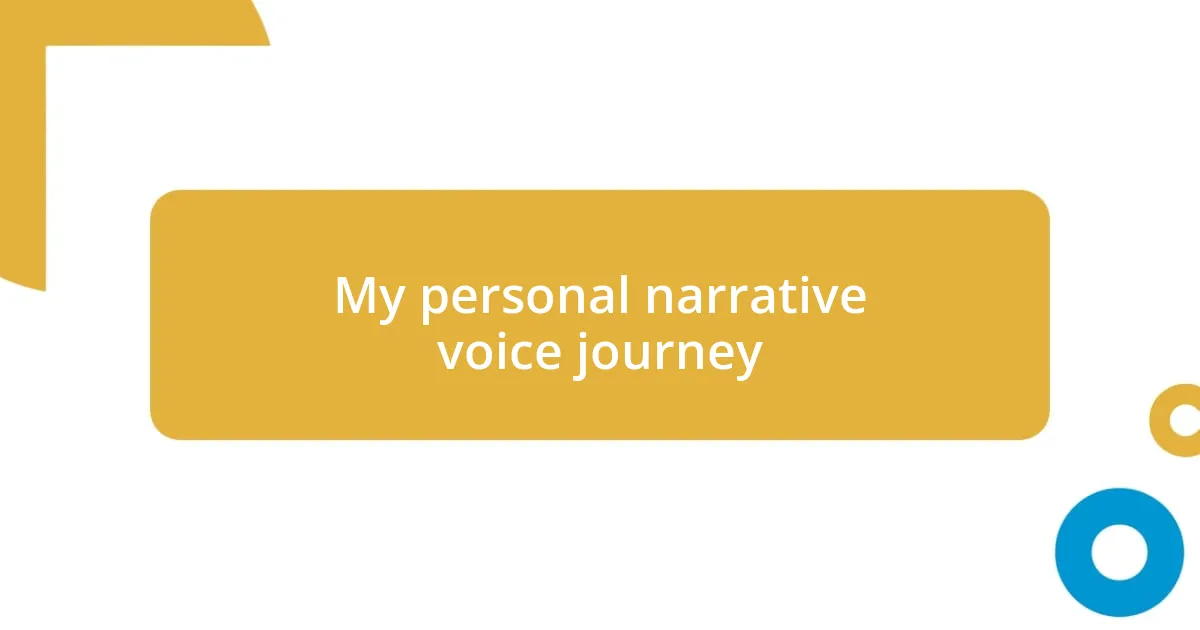
My personal narrative voice journey
Reflecting on my personal journey with narrative voice, I realized it has been both a challenge and a revelation. I recall the first time I wrote a story with a second-person narrative. It felt exhilarating to shape the reader’s experience directly, making them a character in the tale. That shift in perspective not only thrilled me as a writer but also deepened my understanding of how narrative voice can create intimacy.
I’ve also found tremendous value in experimenting with unreliable narrators. There was a short piece I wrote where the protagonist misled the reader with her perceptions. It was almost cathartic to channel her skewed vision of the world. This experience taught me how unreliable voices can craft suspense and provoke thought, challenging readers to discern truth from deception.
Through all these explorations, I’ve come to appreciate that my narrative voice continues to evolve. Each story unveils a new facet of my style, reflecting my growth as a writer. I often wonder if other writers experience this same cycle of transformation. For me, it’s a reminder that embracing change is essential to developing a unique narrative voice that resonates with readers.
| Type of Narrative Voice | Personal Experience |
|---|---|
| First-person | Allowed me to deeply explore a character’s inner thoughts, almost like stepping into their shoes. |
| Second-person | Provided a unique challenge; it made me realize how powerful directly addressing the reader can be. |
| Third-person limited | Gave me the freedom to delve into a character’s emotions while maintaining narrative distance. |
| Third-person omniscient | Helped me to weave multiple perspectives, enriching the storytelling but sometimes feeling overwhelming. |
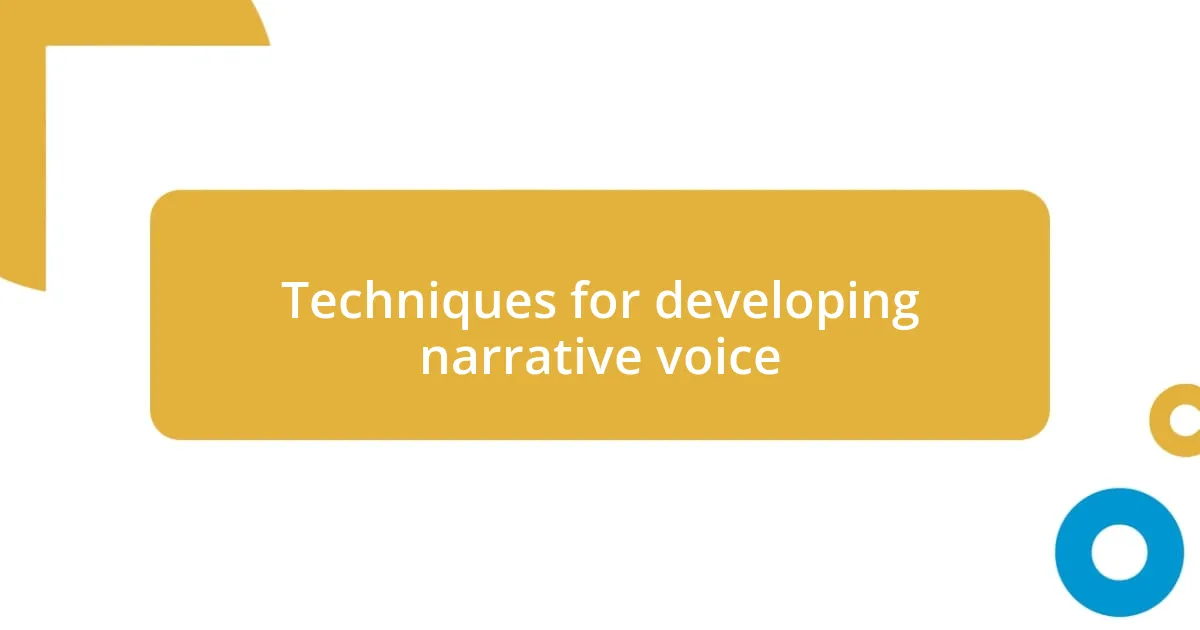
Techniques for developing narrative voice
When it comes to developing a narrative voice, one effective technique is to immerse yourself in the character’s mindset. I often find myself journaling in the voice of my main character before I even start writing the story. This practice helps me not only capture their distinct tone but also embody their emotions and quirks, which adds depth. Have you ever tried this? It can feel like channeling a different person, and it transforms the writing process into a more personal exploration.
Another approach I’ve embraced is experimenting with dialogue and dialect. When I crafted a story set in a rural town, I worked hard to capture the local vernacular. The way characters spoke shaped their identities and brought authenticity to their interactions. I noticed that infusing regional phrases not only made my writing feel more genuine but also helped to establish a unique narrative voice that resonated with readers. Have you considered how specific language influences your narrative?
Lastly, I find that reading widely can significantly influence my narrative voice. I remember poring over works by authors like Toni Morrison and David Mitchell, each with a distinct style. Their narratives taught me the power of rhythm and imagery. Whenever I read something that captivates me, I try to deconstruct it—what is it about their voice that draws me in? This analytical approach has enhanced my own writing, urging me to experiment with new styles and techniques. How often do we reflect on the voices we admire? Understanding these influences is key to refining our own narrative journeys.

Analyzing successful examples
When analyzing successful examples of narrative voice, I often look back at my favorite novels. Take “The Catcher in the Rye,” for instance. Holden Caulfield’s distinctive voice draws readers in with relatable cynicism and vulnerability. I remember feeling an uncanny connection to his struggles. It made me realize how a well-crafted narrative voice can resonate on a deeper level, making characters feel like friends rather than just fictional creations.
Another powerful example is “Room” by Emma Donoghue, narrated from the perspective of a five-year-old boy. I was struck by how the innocence and relentless curiosity of Jack transformed my view on serious themes. This perspective shifted my understanding of narrative voice as a tool not solely for storytelling but also for empathy. Have you ever considered how shifts in narrative perspective can dramatically alter emotional engagement? It’s fascinating to see how such choices can elevate a simple plot into a profound experience.
Additionally, examining the confessionals in “A Streetcar Named Desire” by Tennessee Williams showed me how dialogue can powerfully shape narrative voice. Blanche DuBois’s delicate yet desperate language created tension in every scene, making me feel her fragility. Reflecting on this, I often wonder: how can I mimic that impact in my own writing? It drives home the idea that an engaging narrative voice not only tells a story but also shapes the emotional landscape, leaving an indelible mark on the reader.
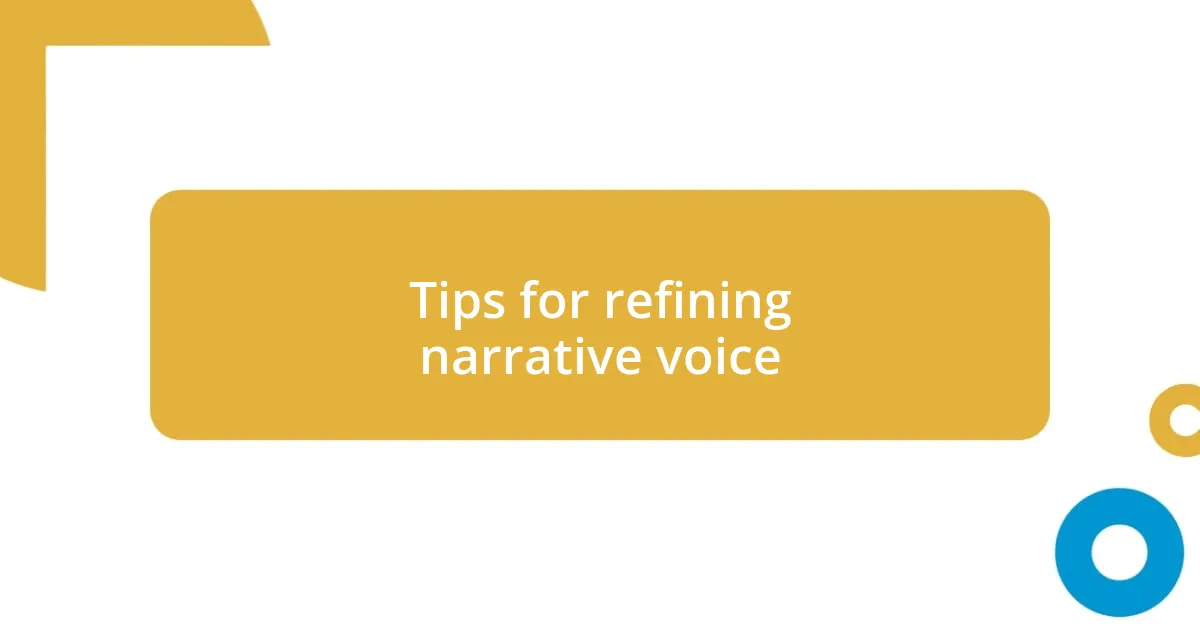
Tips for refining narrative voice
One essential tip I’ve discovered for refining my narrative voice is to embrace authenticity. I remember writing a scene where my protagonist faced a moral dilemma; I decided to draw from a real-life situation that was emotionally charged for me. The result was a voice that felt raw and genuine, resonating with readers who could sense my character’s inner conflict. Have you ever tapped into your own experiences to lend truth to your characters? I find that whenever I do, my writing becomes more compelling.
Another technique that has worked wonders for me is to create a detailed character profile before I start writing. This includes not only their background and motivations but also their unique mannerisms and speech patterns. By visualizing them in different scenarios, I’m able to hone in on their voice. It’s a bit like method acting; the more I immerse myself, the clearer their narrative style comes into focus. Have you considered how a defined character profile can shape the texture of your narrative?
Lastly, I often reflect on the emotional undertones in my writing. I once wrote a short story about a character grappling with loss, and I made sure to use descriptive language that mirrored their grief. This intentional choice made the narrative voice echo the deeper emotions I wanted to convey. How do you ensure that the emotions in your narrative align with the voice? Balancing emotion with voice not only enhances the reading experience but also makes the characters feel more relatable and multifaceted.












